radiator cap CHRYSLER VOYAGER 2023 Owners Manual
[x] Cancel search | Manufacturer: CHRYSLER, Model Year: 2023, Model line: VOYAGER, Model: CHRYSLER VOYAGER 2023Pages: 256, PDF Size: 13.97 MB
Page 189 of 256
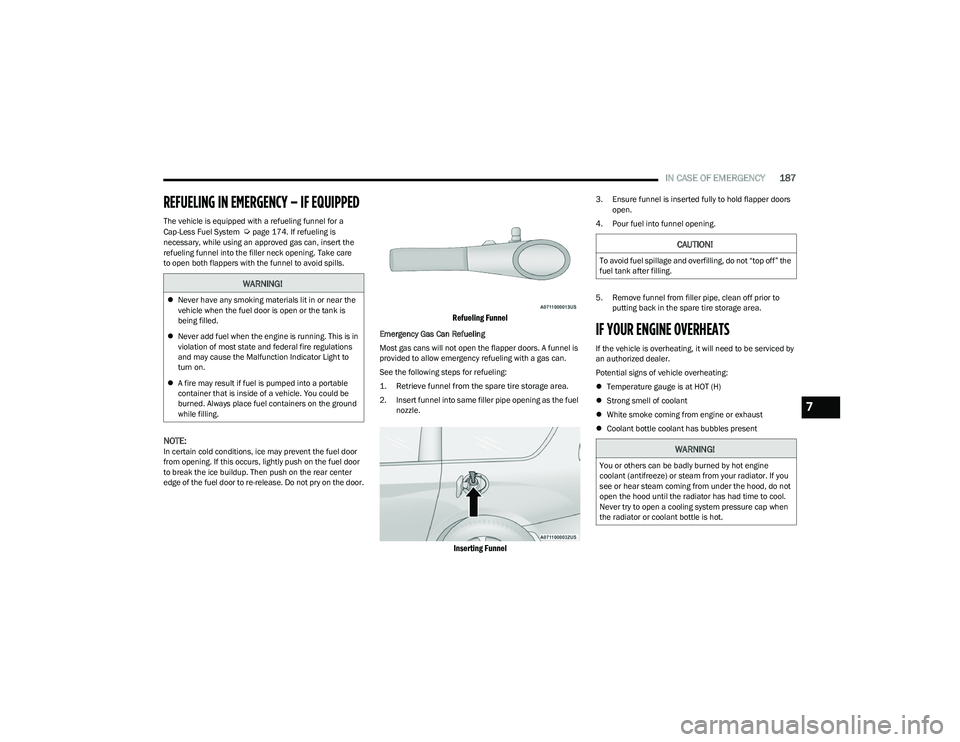
IN CASE OF EMERGENCY187
REFUELING IN EMERGENCY – IF EQUIPPED
The vehicle is equipped with a refueling funnel for a
Cap-Less Fuel System Úpage 174. If refueling is
necessary, while using an approved gas can, insert the
refueling funnel into the filler neck opening. Take care
to open both flappers with the funnel to avoid spills.
NOTE:In certain cold conditions, ice may prevent the fuel door
from opening. If this occurs, lightly push on the fuel door
to break the ice buildup. Then push on the rear center
edge of the fuel door to re-release. Do not pry on the door.
Refueling Funnel
Emergency Gas Can Refueling
Most gas cans will not open the flapper doors. A funnel is
provided to allow emergency refueling with a gas can.
See the following steps for refueling:
1. Retrieve funnel from the spare tire storage area.
2. Insert funnel into same filler pipe opening as the fuel nozzle.
Inserting Funnel
3. Ensure funnel is inserted fully to hold flapper doors open.
4. Pour fuel into funnel opening.
5. Remove funnel from filler pipe, clean off prior to putting back in the spare tire storage area.
IF YOUR ENGINE OVERHEATS
If the vehicle is overheating, it will need to be serviced by
an authorized dealer.
Potential signs of vehicle overheating:
Temperature gauge is at HOT (H)
Strong smell of coolant
White smoke coming from engine or exhaust
Coolant bottle coolant has bubbles present
WARNING!
Never have any smoking materials lit in or near the
vehicle when the fuel door is open or the tank is
being filled.
Never add fuel when the engine is running. This is in
violation of most state and federal fire regulations
and may cause the Malfunction Indicator Light to
turn on.
A fire may result if fuel is pumped into a portable
container that is inside of a vehicle. You could be
burned. Always place fuel containers on the ground
while filling.
CAUTION!
To avoid fuel spillage and overfilling, do not “top off” the
fuel tank after filling.
WARNING!
You or others can be badly burned by hot engine
coolant (antifreeze) or steam from your radiator. If you
see or hear steam coming from under the hood, do not
open the hood until the radiator has had time to cool.
Never try to open a cooling system pressure cap when
the radiator or coolant bottle is hot.
7
23_RUV_OM_EN_US_t.book Page 187
Page 206 of 256
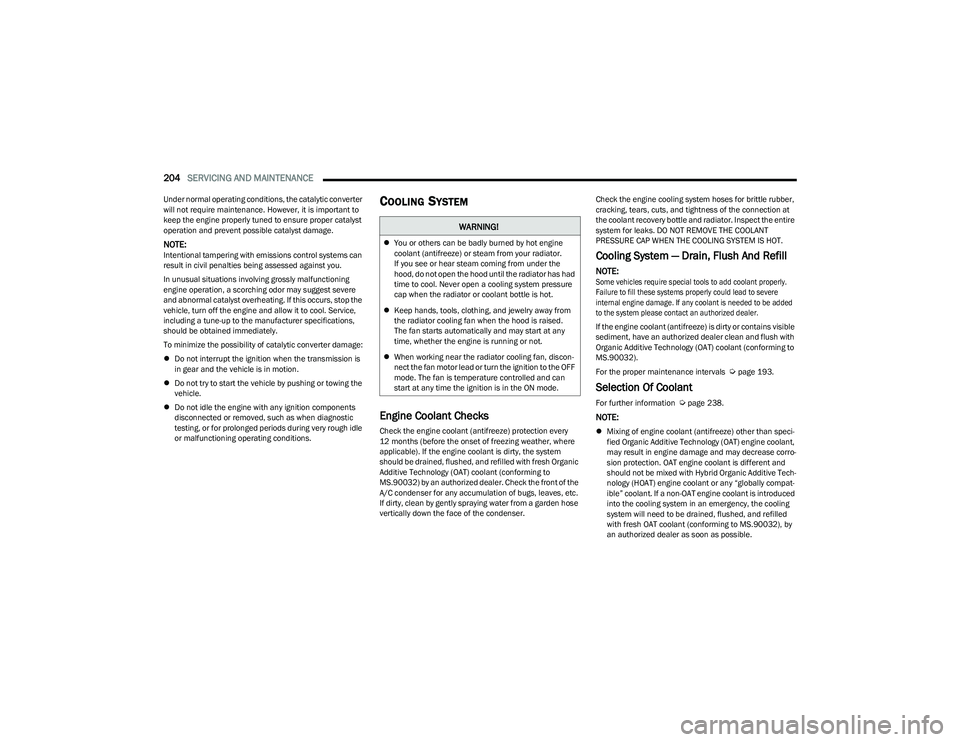
204SERVICING AND MAINTENANCE
Under normal operating conditions, the catalytic converter
will not require maintenance. However, it is important to
keep the engine properly tuned to ensure proper catalyst
operation and prevent possible catalyst damage.
NOTE:Intentional tampering with emissions control systems can
result in civil penalties being assessed against you.
In unusual situations involving grossly malfunctioning
engine operation, a scorching odor may suggest severe
and abnormal catalyst overheating. If this occurs, stop the
vehicle, turn off the engine and allow it to cool. Service,
including a tune-up to the manufacturer specifications,
should be obtained immediately.
To minimize the possibility of catalytic converter damage:
Do not interrupt the ignition when the transmission is
in gear and the vehicle is in motion.
Do not try to start the vehicle by pushing or towing the
vehicle.
Do not idle the engine with any ignition components
disconnected or removed, such as when diagnostic
testing, or for prolonged periods during very rough idle
or malfunctioning operating conditions.
COOLING SYSTEM
Engine Coolant Checks
Check the engine coolant (antifreeze) protection every
12 months (before the onset of freezing weather, where
applicable). If the engine coolant is dirty, the system
should be drained, flushed, and refilled with fresh Organic
Additive Technology (OAT) coolant (conforming to
MS.90032) by an authorized dealer. Check the front of the
A/C condenser for any accumulation of bugs, leaves, etc.
If dirty, clean by gently spraying water from a garden hose
vertically down the face of the condenser. Check the engine cooling system hoses for brittle rubber,
cracking, tears, cuts, and tightness of the connection at
the coolant recovery bottle and radiator. Inspect the entire
system for leaks. DO NOT REMOVE THE COOLANT
PRESSURE CAP WHEN THE COOLING SYSTEM IS HOT.
Cooling System — Drain, Flush And Refill
NOTE:
Some vehicles require special tools to add coolant properly.
Failure to fill these systems properly could lead to severe
internal engine damage. If any coolant is needed to be added
to the system please contact an authorized dealer.
If the engine coolant (antifreeze) is dirty or contains visible
sediment, have an authorized dealer clean and flush with
Organic Additive Technology (OAT) coolant (conforming to
MS.90032).
For the proper maintenance intervals
Úpage 193.
Selection Of Coolant
For further information Úpage 238.
NOTE:
Mixing of engine coolant (antifreeze) other than speci-
fied Organic Additive Technology (OAT) engine coolant,
may result in engine damage and may decrease corro -
sion protection. OAT engine coolant is different and
should not be mixed with Hybrid Organic Additive Tech -
nology (HOAT) engine coolant or any “globally compat -
ible” coolant. If a non-OAT engine coolant is introduced
into the cooling system in an emergency, the cooling
system will need to be drained, flushed, and refilled
with fresh OAT coolant (conforming to MS.90032), by
an authorized dealer as soon as possible.
WARNING!
You or others can be badly burned by hot engine
coolant (antifreeze) or steam from your radiator.
If you see or hear steam coming from under the
hood, do not open the hood until the radiator has had
time to cool. Never open a cooling system pressure
cap when the radiator or coolant bottle is hot.
Keep hands, tools, clothing, and jewelry away from
the radiator cooling fan when the hood is raised.
The fan starts automatically and may start at any
time, whether the engine is running or not.
When working near the radiator cooling fan, discon -
nect the fan motor lead or turn the ignition to the OFF
mode. The fan is temperature controlled and can
start at any time the ignition is in the ON mode.
23_RUV_OM_EN_US_t.book Page 204
Page 207 of 256
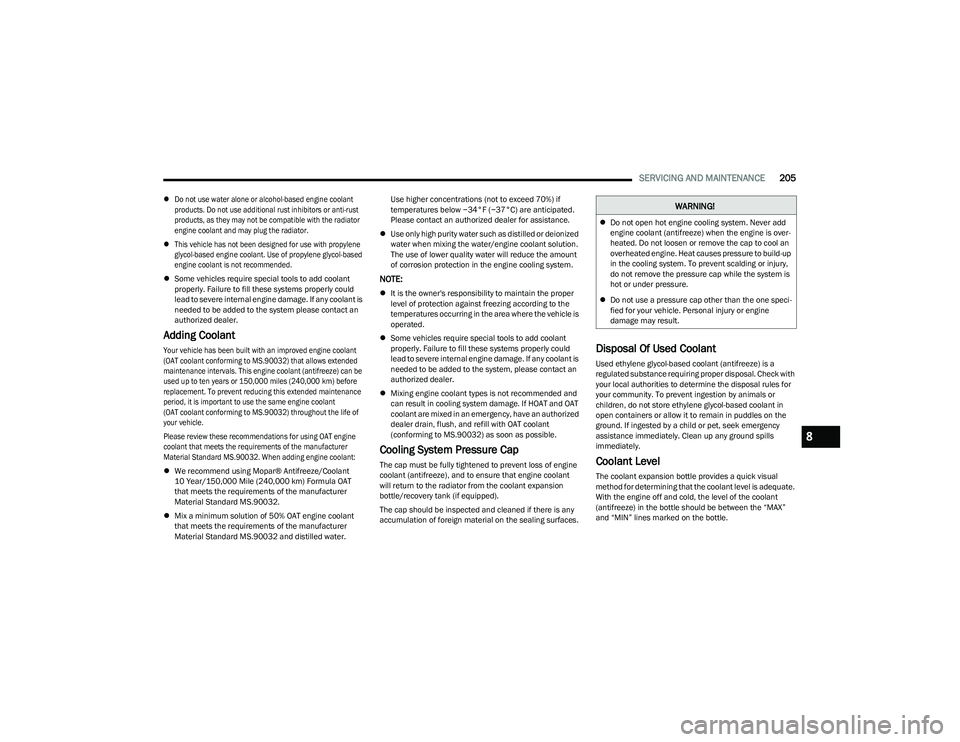
SERVICING AND MAINTENANCE205
Do not use water alone or alcohol-based engine coolant
products. Do not use additional rust inhibitors or anti-rust
products, as they may not be compatible with the radiator
engine coolant and may plug the radiator.
This vehicle has not been designed for use with propylene
glycol-based engine coolant. Use of propylene glycol-based
engine coolant is not recommended.
Some vehicles require special tools to add coolant
properly. Failure to fill these systems properly could
lead to severe internal engine damage. If any coolant is
needed to be added to the system please contact an
authorized dealer.
Adding Coolant
Your vehicle has been built with an improved engine coolant
(OAT coolant conforming to MS.90032) that allows extended
maintenance intervals. This engine coolant (antifreeze) can be
used up to ten years or 150,000 miles (240,000 km) before
replacement. To prevent reducing this extended maintenance
period, it is important to use the same engine coolant
(OAT coolant conforming to MS.90032) throughout the life of
your vehicle.
Please review these recommendations for using OAT engine
coolant that meets the requirements of the manufacturer
Material Standard MS.90032. When adding engine coolant:
We recommend using Mopar® Antifreeze/Coolant
10 Year/150,000 Mile (240,000 km) Formula OAT
that meets the requirements of the manufacturer
Material Standard MS.90032.
Mix a minimum solution of 50% OAT engine coolant
that meets the requirements of the manufacturer
Material Standard MS.90032 and distilled water. Use higher concentrations (not to exceed 70%) if
temperatures below −34°F (−37°C) are anticipated.
Please contact an authorized dealer for assistance.
Use only high purity water such as distilled or deionized
water when mixing the water/engine coolant solution.
The use of lower quality water will reduce the amount
of corrosion protection in the engine cooling system.
NOTE:
It is the owner's responsibility to maintain the proper
level of protection against freezing according to the
temperatures occurring in the area where the vehicle is
operated.
Some vehicles require special tools to add coolant
properly. Failure to fill these systems properly could
lead to severe internal engine damage. If any coolant is
needed to be added to the system, please contact an
authorized dealer.
Mixing engine coolant types is not recommended and
can result in cooling system damage. If HOAT and OAT
coolant are mixed in an emergency, have an authorized
dealer drain, flush, and refill with OAT coolant
(conforming to MS.90032) as soon as possible.
Cooling System Pressure Cap
The cap must be fully tightened to prevent loss of engine
coolant (antifreeze), and to ensure that engine coolant
will return to the radiator from the coolant expansion
bottle/recovery tank (if equipped).
The cap should be inspected and cleaned if there is any
accumulation of foreign material on the sealing surfaces.
Disposal Of Used Coolant
Used ethylene glycol-based coolant (antifreeze) is a
regulated substance requiring proper disposal. Check with
your local authorities to determine the disposal rules for
your community. To prevent ingestion by animals or
children, do not store ethylene glycol-based coolant in
open containers or allow it to remain in puddles on the
ground. If ingested by a child or pet, seek emergency
assistance immediately. Clean up any ground spills
immediately.
Coolant Level
The coolant expansion bottle provides a quick visual
method for determining that the coolant level is adequate.
With the engine off and cold, the level of the coolant
(antifreeze) in the bottle should be between the “MAX”
and “MIN” lines marked on the bottle.
WARNING!
Do not open hot engine cooling system. Never add
engine coolant (antifreeze) when the engine is over -
heated. Do not loosen or remove the cap to cool an
overheated engine. Heat causes pressure to build-up
in the cooling system. To prevent scalding or injury,
do not remove the pressure cap while the system is
hot or under pressure.
Do not use a pressure cap other than the one speci -
fied for your vehicle. Personal injury or engine
damage may result.
8
23_RUV_OM_EN_US_t.book Page 205
Page 208 of 256
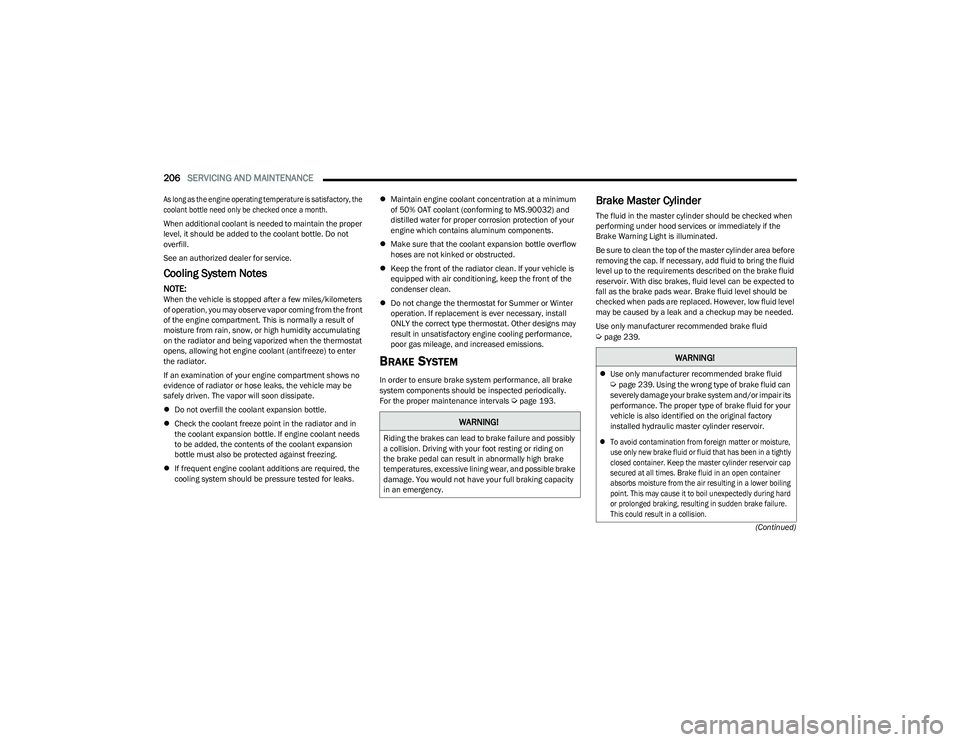
206SERVICING AND MAINTENANCE
(Continued)
As long as the engine operating temperature is satisfactory, the
coolant bottle need only be checked once a month.
When additional coolant is needed to maintain the proper
level, it should be added to the coolant bottle. Do not
overfill.
See an authorized dealer for service.
Cooling System Notes
NOTE:When the vehicle is stopped after a few miles/kilometers
of operation, you may observe vapor coming from the front
of the engine compartment. This is normally a result of
moisture from rain, snow, or high humidity accumulating
on the radiator and being vaporized when the thermostat
opens, allowing hot engine coolant (antifreeze) to enter
the radiator.
If an examination of your engine compartment shows no
evidence of radiator or hose leaks, the vehicle may be
safely driven. The vapor will soon dissipate.
Do not overfill the coolant expansion bottle.
Check the coolant freeze point in the radiator and in
the coolant expansion bottle. If engine coolant needs
to be added, the contents of the coolant expansion
bottle must also be protected against freezing.
If frequent engine coolant additions are required, the
cooling system should be pressure tested for leaks.
Maintain engine coolant concentration at a minimum
of 50% OAT coolant (conforming to MS.90032) and
distilled water for proper corrosion protection of your
engine which contains aluminum components.
Make sure that the coolant expansion bottle overflow
hoses are not kinked or obstructed.
Keep the front of the radiator clean. If your vehicle is
equipped with air conditioning, keep the front of the
condenser clean.
Do not change the thermostat for Summer or Winter
operation. If replacement is ever necessary, install
ONLY the correct type thermostat. Other designs may
result in unsatisfactory engine cooling performance,
poor gas mileage, and increased emissions.
BRAKE SYSTEM
In order to ensure brake system performance, all brake
system components should be inspected periodically.
For the proper maintenance intervals
Úpage 193.
Brake Master Cylinder
The fluid in the master cylinder should be checked when
performing under hood services or immediately if the
Brake Warning Light is illuminated.
Be sure to clean the top of the master cylinder area before
removing the cap. If necessary, add fluid to bring the fluid
level up to the requirements described on the brake fluid
reservoir. With disc brakes, fluid level can be expected to
fall as the brake pads wear. Brake fluid level should be
checked when pads are replaced. However, low fluid level
may be caused by a leak and a checkup may be needed.
Use only manufacturer recommended brake fluid
Úpage 239.
WARNING!
Riding the brakes can lead to brake failure and possibly
a collision. Driving with your foot resting or riding on
the brake pedal can result in abnormally high brake
temperatures, excessive lining wear, and possible brake
damage. You would not have your full braking capacity
in an emergency.
WARNING!
Use only manufacturer recommended brake fluid Úpage 239. Using the wrong type of brake fluid can
severely damage your brake system and/or impair its
performance. The proper type of brake fluid for your
vehicle is also identified on the original factory
installed hydraulic master cylinder reservoir.
To avoid contamination from foreign matter or moisture,
use only new brake fluid or fluid that has been in a tightly
closed container. Keep the master cylinder reservoir cap
secured at all times. Brake fluid in an open container
absorbs moisture from the air resulting in a lower boiling
point. This may cause it to boil unexpectedly during hard
or prolonged braking, resulting in sudden brake failure.
This could result in a collision.
23_RUV_OM_EN_US_t.book Page 206
Page 248 of 256
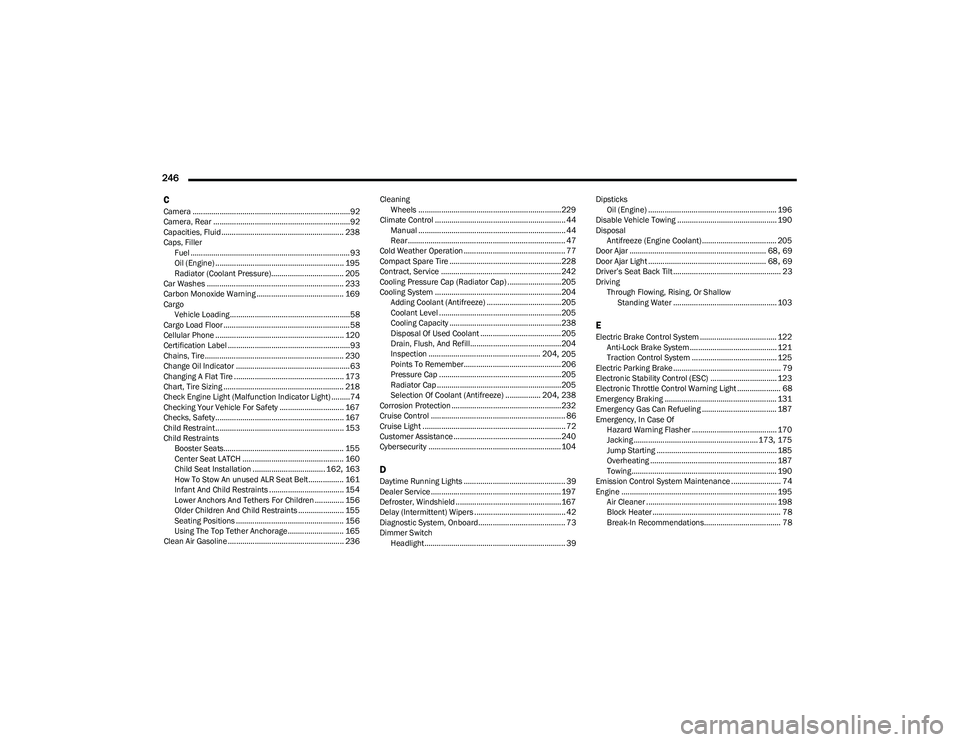
246 C
Camera ............................................................................92
Camera, Rear ..................................................................92
Capacities, Fluid ........................................................... 238
Caps, Filler Fuel .............................................................................93
Oil (Engine) .............................................................. 195
Radiator (Coolant Pressure)................................... 205
Car Washes .................................................................. 233
Carbon Monoxide Warning .......................................... 169
Cargo Vehicle Loading..........................................................58
Cargo Load Floor ............................................................. 58
Cellular Phone .............................................................. 120
Certification Label ...........................................................93
Chains, Tire................................................................... 230
Change Oil Indicator ....................................................... 63
Changing A Flat Tire ..................................................... 173
Chart, Tire Sizing .......................................................... 218
Check Engine Light (Malfunction Indicator Light) .........74
Checking Your Vehicle For Safety ............................... 167
Checks, Safety.............................................................. 167
Child Restraint.............................................................. 153
Child Restraints Booster Seats.......................................................... 155
Center Seat LATCH ................................................. 160Child Seat Installation ................................... 162
, 163
How To Stow An unused ALR Seat Belt ................. 161
Infant And Child Restraints .................................... 154 Lower Anchors And Tethers For Children .............. 156Older Children And Child Restraints ...................... 155
Seating Positions .................................................... 156
Using The Top Tether Anchorage........................... 165
Clean Air Gasoline........................................................ 236 Cleaning
Wheels .....................................................................229
Climate Control ............................................................... 44 Manual ....................................................................... 44
Rear ............................................................................ 47
Cold Weather Operation ................................................. 77
Compact Spare Tire ...................................................... 228
Contract, Service .......................................................... 242
Cooling Pressure Cap (Radiator Cap) ..........................205
Cooling System ............................................................. 204 Adding Coolant (Antifreeze) ....................................205
Coolant Level ...........................................................205
Cooling Capacity ...................................................... 238
Disposal Of Used Coolant ....................................... 205Drain, Flush, And Refill............................................204
Inspection ...................................................... 204
, 205
Points To Remember............................................... 206
Pressure Cap ...........................................................205
Radiator Cap ............................................................205 Selection Of Coolant (Antifreeze) ................. 204
, 238
Corrosion Protection ..................................................... 232
Cruise Control ................................................................. 86
Cruise Light ..................................................................... 72
Customer Assistance ....................................................240
Cybersecurity ................................................................ 104
DDaytime Running Lights ................................................. 39
Dealer Service............................................................... 197
Defroster, Windshield ...................................................167
Delay (Intermittent) Wipers ............................................ 42
Diagnostic System, Onboard.......................................... 73
Dimmer Switch Headlight .................................................................... 39 Dipsticks
Oil (Engine) .............................................................. 196
Disable Vehicle Towing ................................................ 190
Disposal Antifreeze (Engine Coolant) .................................... 205
Door Ajar .................................................................. 68
, 69
Door Ajar Light ......................................................... 68, 69
Driver’s Seat Back Tilt .................................................... 23
Driving Through Flowing, Rising, Or Shallow Standing Water .................................................. 103
EElectric Brake Control System ..................................... 122Anti-Lock Brake System .......................................... 121Traction Control System ......................................... 125
Electric Parking Brake.................................................... 79
Electronic Stability Control (ESC) ................................ 123
Electronic Throttle Control Warning Light ..................... 68
Emergency Braking ...................................................... 131
Emergency Gas Can Refueling .................................... 187
Emergency, In Case Of Hazard Warning Flasher ......................................... 170Jacking ............................................................ 173
, 175
Jump Starting .......................................................... 185
Overheating ............................................................. 187
Towing...................................................................... 190
Emission Control System Maintenance ........................ 74
Engine ........................................................................... 195 Air Cleaner ............................................................... 198Block Heater .............................................................. 78
Break-In Recommendations..................................... 78
23_RUV_OM_EN_US_t.book Page 246
Page 251 of 256
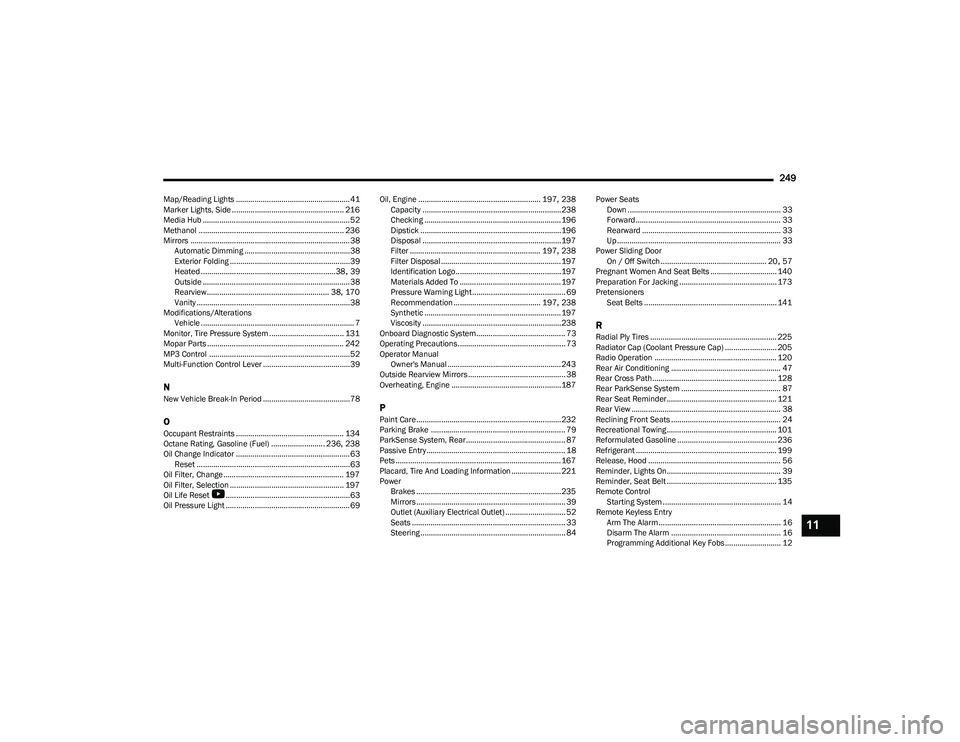
249
Map/Reading Lights ....................................................... 41
Marker Lights, Side ...................................................... 216
Media Hub ....................................................................... 52Methanol ...................................................................... 236
Mirrors .............................................................................38 Automatic Dimming ...................................................38
Exterior Folding ..........................................................39
Heated .................................................................38
, 39
Outside ....................................................................... 38
Rearview ........................................................... 38
, 170
Vanity ..........................................................................38
Modifications/Alterations Vehicle .......................................................................... 7
Monitor, Tire Pressure System .................................... 131
Mopar Parts .................................................................. 242
MP3 Control ....................................................................52
Multi-Function Control Lever ..........................................39
NNew Vehicle Break-In Period ..........................................78
OOccupant Restraints .................................................... 134
Octane Rating, Gasoline (Fuel) .......................... 236, 238
Oil Change Indicator ....................................................... 63 Reset ..........................................................................63
Oil Filter, Change .......................................................... 197
Oil Filter, Selection ....................................................... 197
Oil Life Reset
b
............................................................63
Oil Pressure Light ............................................................69 Oil, Engine ........................................................... 197
, 238
Capacity ...................................................................238 Checking .................................................................. 196
Dipstick ....................................................................196Disposal ...................................................................197Filter ............................................................... 197
, 238
Filter Disposal .......................................................... 197
Identification Logo...................................................197
Materials Added To ................................................. 197
Pressure Warning Light............................................. 69
Recommendation .......................................... 197
, 238
Synthetic .................................................................. 197
Viscosity ...................................................................238
Onboard Diagnostic System........................................... 73
Operating Precautions.................................................... 73 Operator Manual Owner's Manual ....................................................... 243
Outside Rearview Mirrors............................................... 38
Overheating, Engine ..................................................... 187
PPaint Care...................................................................... 232
Parking Brake ................................................................. 79
ParkSense System, Rear................................................ 87
Passive Entry................................................................... 18 Pets ................................................................................ 167
Placard, Tire And Loading Information ........................ 221
Power Brakes ...................................................................... 235
Mirrors ........................................................................ 39
Outlet (Auxiliary Electrical Outlet) ............................. 52
Seats .......................................................................... 33
Steering ...................................................................... 84 Power Seats
Down .......................................................................... 33
Forward ...................................................................... 33
Rearward ................................................................... 33
Up ............................................................................... 33
Power Sliding Door On / Off Switch ................................................... 20
, 57
Pregnant Women And Seat Belts ................................ 140
Preparation For Jacking ............................................... 173
Pretensioners Seat Belts ................................................................ 141
RRadial Ply Tires ............................................................. 225
Radiator Cap (Coolant Pressure Cap) ......................... 205
Radio Operation ........................................................... 120
Rear Air Conditioning ..................................................... 47
Rear Cross Path............................................................ 128
Rear ParkSense System ................................................ 87Rear Seat Reminder ..................................................... 121
Rear View ........................................................................ 38
Reclining Front Seats ..................................................... 24
Recreational Towing ..................................................... 101
Reformulated Gasoline ................................................ 236
Refrigerant .................................................................... 199
Release, Hood ................................................................ 56
Reminder, Lights On....................................................... 39Reminder, Seat Belt ..................................................... 135
Remote Control Starting System ......................................................... 14
Remote Keyless Entry Arm The Alarm ........................................................... 16
Disarm The Alarm ..................................................... 16
Programming Additional Key Fobs ........................... 12
11
23_RUV_OM_EN_US_t.book Page 249